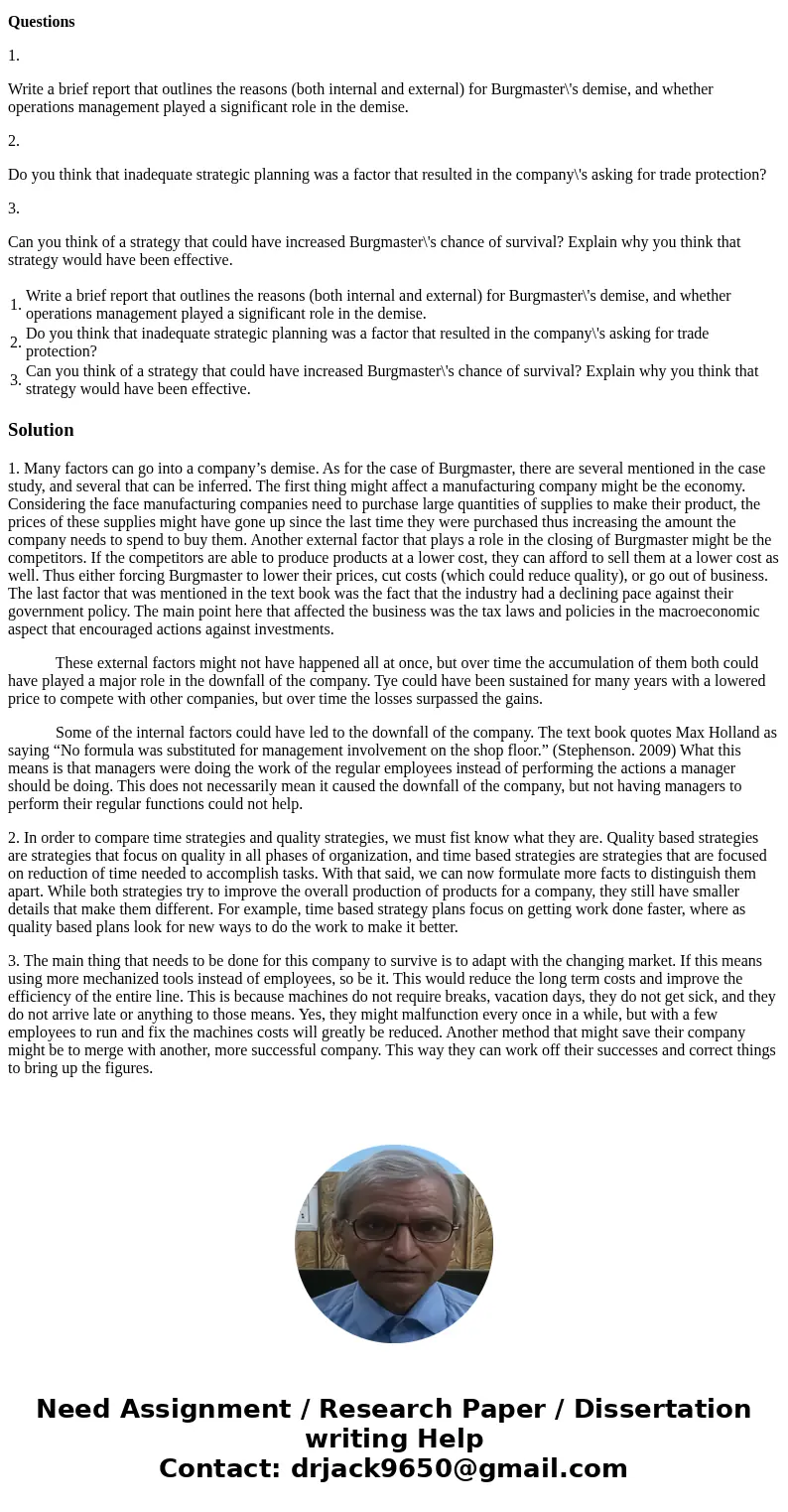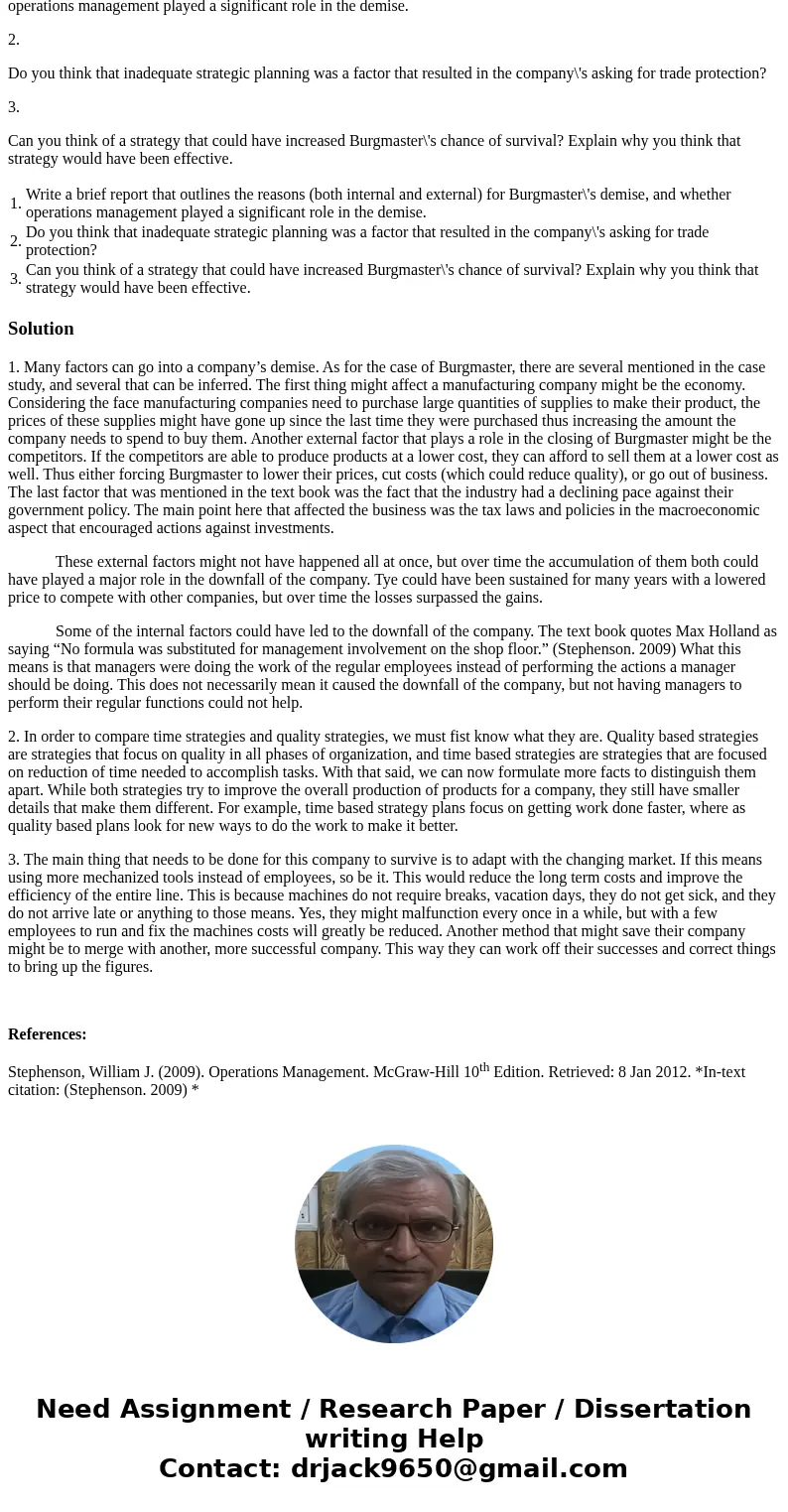Zachary Schiller The Rust Belt is back So say bullish observ
Zachary Schiller
The Rust Belt is back. So say bullish observers as U.S. exports surge, long-moribund industries glow with newfound profits, and unemployment dips to lows not seen in a decade. But in the smokestack citadels, there\'s disquiet. Too many machine-tool and auto parts factories are silent; too many U.S. industries still can\'t hold their own.
What went wrong since the heyday of the 1960s? That\'s the issue Max Holland, a contributing editor of The Nation, takes up in his nutsy-boltsy but fascinating study, When the Machine Stopped.*
The focus of the story is Burgmaster Corp., a Los Angeles–area machine-tool maker founded in 1944 by Czechoslovakian immigrant Fred Burg. Holland\'s father worked there for 29 years, and the author interviewed 22 former employees. His shop-floor view of this small company is a refreshing change from academic treatises on why America can\'t compete.
The discussions of spindles and numerical control can be tough going. But Holland compensates by conveying the excitement and innovation of the company\'s early days and the disgust and cynicism accompanying its decline. Moreover, the fate of Burgmaster and its brethren is crucial to the U.S. industrial economy: Any manufactured item is either made by a machine tool or by a machine made by a machine tool.
Producing innovative turret drills used in a wide variety of metal working tasks, Burgmaster was a thriving enterprise by 1965, when annual sales amounted to about $8 million. The company needed backing to expand, however, so it sold out to Buffalo-based conglomerate Houdaille Industries Inc. Houdaille was in turn purchased in a 1979 leveraged buyout (LBO) led by Kohlberg Kravis Roberts & Co. By 1982, when debt, competition, and a sickly machine-tool market had battered Burgmaster badly, Houdaille went to Washington with a petition to withhold the investment tax credit for certain Japanese-made machine tools.
Thanks to deft lobbying, the Senate passed a resolution supporting Houdaille\'s position, but President Reagan refused to go along. Houdaille\'s subsequent attempt to link Burgmaster up with a Japanese rival also failed, and Burgmaster was closed.
Holland uses Burgmaster\'s demise to explore some key issues of economic and trade policy. Houdaille\'s charge that a cartel led by the Japanese government had injured U.S. toolmakers, for example, became a rallying point for those who would blame a fearsome Japan Inc. for the problems of U.S. industry.
Holland describes the Washington wrangling over Houdaille in painful detail. But he does show that such government decisions are often made without much knowledge of what\'s going on in industry. He shows, too, that Japanese producers succeeded less because of government help than because they made better, cheaper machines.
For those who see LBOs as a symptom of what ails the U.S. economy, Holland offers plenty of ammunition. He argues persuasively that the LBO crippled Burgmaster by creating enormous pressure to generate cash. As Burgmaster pushed its products out as fast as possible, he writes, it routinely shipped defective machines. It promised customers features that engineers hadn\'t yet designed. And although KKR disputes the claim, Holland concludes that the LBO choked off Burgmaster\'s investment funds just when foreign competition made them most necessary. As for Houdaille, it was recapitalized and sold to Britain\'s Tube Investments Group.
But Burgmaster\'s problems had started even before the LBO. Holland\'s history of the company under Houdaille is a veritable catalog of modern management techniques that flopped. One of the most disastrous was a system for computerizing production scheduling that was too crude for complex machine-tool manufacturing. Holland gives a dramatic depiction of supply snafus that resulted in delays and cost increases.
As an independent company, “Burgmaster thrived because the Burgs knew their business,” Holland writes. Their departure under Houdaille was followed by an “endless and ultimately futile search for a better formula.” But, he concludes: “No formula was a substitute for management involvement on the shop floor.”
In the end, however, Holland puts most of the blame for the industry\'s decline on government policy. He targets tax laws and macroeconomic policies that encourage LBOs and speculation instead of productive investment. He also criticizes Pentagon procurement policies for favoring exotic, custom machines over standard, low-cost models. This adds up to an industrial policy, Holland writes—a bad one.
The point is well taken, but Holland gives it excessive weight. Like their brethren in Detroit and Pittsburgh, domestic tool-makers in the 1970s were too complacent when imports seized the lower end of the product line. The conservatism that had for years served them in their cyclical industry left them ill-prepared for change. Even now some of the largest U.S. tool-makers are struggling to restructure. Blame the government, yes. But blame the industry, too.
Questions
1.
Write a brief report that outlines the reasons (both internal and external) for Burgmaster\'s demise, and whether operations management played a significant role in the demise.
2.
Do you think that inadequate strategic planning was a factor that resulted in the company\'s asking for trade protection?
3.
Can you think of a strategy that could have increased Burgmaster\'s chance of survival? Explain why you think that strategy would have been effective.
| 1. | Write a brief report that outlines the reasons (both internal and external) for Burgmaster\'s demise, and whether operations management played a significant role in the demise. | |
| 2. | Do you think that inadequate strategic planning was a factor that resulted in the company\'s asking for trade protection? | |
| 3. | Can you think of a strategy that could have increased Burgmaster\'s chance of survival? Explain why you think that strategy would have been effective. |
Solution
1. Many factors can go into a company’s demise. As for the case of Burgmaster, there are several mentioned in the case study, and several that can be inferred. The first thing might affect a manufacturing company might be the economy. Considering the face manufacturing companies need to purchase large quantities of supplies to make their product, the prices of these supplies might have gone up since the last time they were purchased thus increasing the amount the company needs to spend to buy them. Another external factor that plays a role in the closing of Burgmaster might be the competitors. If the competitors are able to produce products at a lower cost, they can afford to sell them at a lower cost as well. Thus either forcing Burgmaster to lower their prices, cut costs (which could reduce quality), or go out of business. The last factor that was mentioned in the text book was the fact that the industry had a declining pace against their government policy. The main point here that affected the business was the tax laws and policies in the macroeconomic aspect that encouraged actions against investments.
These external factors might not have happened all at once, but over time the accumulation of them both could have played a major role in the downfall of the company. Tye could have been sustained for many years with a lowered price to compete with other companies, but over time the losses surpassed the gains.
Some of the internal factors could have led to the downfall of the company. The text book quotes Max Holland as saying “No formula was substituted for management involvement on the shop floor.” (Stephenson. 2009) What this means is that managers were doing the work of the regular employees instead of performing the actions a manager should be doing. This does not necessarily mean it caused the downfall of the company, but not having managers to perform their regular functions could not help.
2. In order to compare time strategies and quality strategies, we must fist know what they are. Quality based strategies are strategies that focus on quality in all phases of organization, and time based strategies are strategies that are focused on reduction of time needed to accomplish tasks. With that said, we can now formulate more facts to distinguish them apart. While both strategies try to improve the overall production of products for a company, they still have smaller details that make them different. For example, time based strategy plans focus on getting work done faster, where as quality based plans look for new ways to do the work to make it better.
3. The main thing that needs to be done for this company to survive is to adapt with the changing market. If this means using more mechanized tools instead of employees, so be it. This would reduce the long term costs and improve the efficiency of the entire line. This is because machines do not require breaks, vacation days, they do not get sick, and they do not arrive late or anything to those means. Yes, they might malfunction every once in a while, but with a few employees to run and fix the machines costs will greatly be reduced. Another method that might save their company might be to merge with another, more successful company. This way they can work off their successes and correct things to bring up the figures.
References:
Stephenson, William J. (2009). Operations Management. McGraw-Hill 10th Edition. Retrieved: 8 Jan 2012. *In-text citation: (Stephenson. 2009) *



 Homework Sourse
Homework Sourse